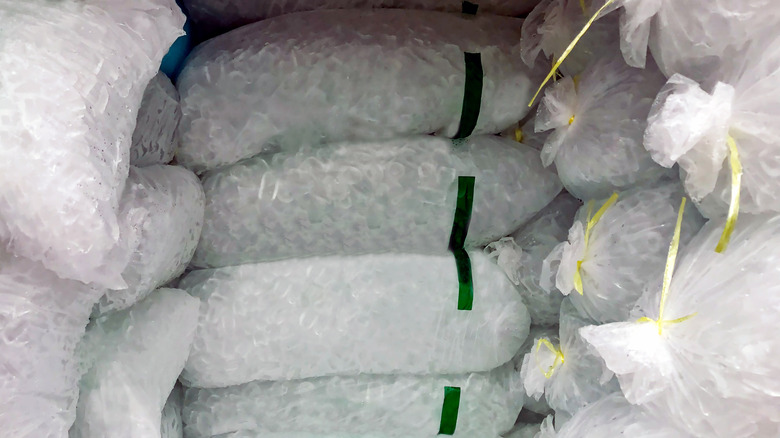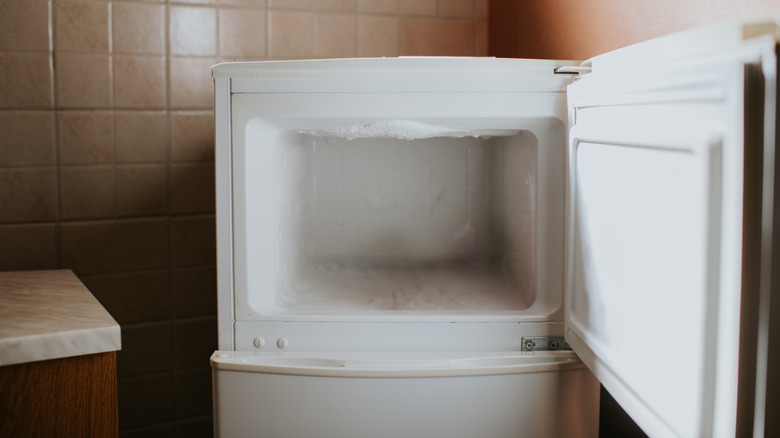Why Bagged Ice May Not Be As Clean As You Think
Bagged ice might seem like a safe bet on a hot day because it's clean, packaged, and ready to dump into a cooler or cocktail ... but is it? Just because it looks clear doesn't mean it's free from contamination, which is what a lot of people fall victim to when it comes to ice or clear water in general. Though we assume store-bought ice is made from filtered water and handled with care, studies say otherwise.
The source of the problem isn't always the water either, as it can also be the machines used to process and bag the ice, or the workers who handle it without gloves or proper sanitation. Once frozen, those bacteria can stick around and get transferred to your hands, food, or drink as the ice melts. And if you think freezing kills all germs, think again, because many pathogens can survive low temperatures and lie dormant in the ice until they thaw.
A 2017 study in the Journal of Food Protection looked specifically at packaged ice and found that 19% of samples exceeded the microbial safety threshold of 500 colony-forming units per milliliter. Even more alarming, 34% tested positive for Staphylococci, suggesting improper sanitation during ice handling or packaging. Complementing this, a 2024 review published in Microorganisms found that ice produced onsite or locally — such as from gas stations or small vendors — was more likely to be contaminated with fungi, viruses, or bacteria like Pseudomonas, Vibrio, or E. coli (which is one of the most common reasons food products are recalled).
These findings highlight concerns around cleanliness and handling practices outside of regulated factory environments. Together, these studies reinforce that bagged ice, while convenient, isn't always as clean as it appears, especially when sourced from less controlled production environments.
Freezing doesn't equal sterilizing
One of the biggest misconceptions about ice is that freezing temperatures make it safe. It's true that freezing can slow or pause bacterial growth, but it doesn't actually kill most microbes, which is a big deal when you consider that ice often comes into direct contact with drinks, fruits, or ready-to-eat foods. And once ice melts, any surviving bacteria can become active again, making bagged ice a surprising vector for foodborne illness, especially if it's not made or stored properly. It's kind of along the same lines as considering how long food stays safe to eat when it's in a cooler. Those cold temperatures only work for so long.
The Food and Drug Administration does require that commercial ice meet drinking water standards, but enforcement and regular inspections vary by state and region. Additionally, once the ice is delivered and stored at a retail location, there's no guarantee employees are following hygienic practices, so don't assume cleanliness just because ice is packaged. Always check the bag for signs of tampering, and don't use ice that smells off, looks cloudy, or was stored near raw meat or uncovered food.
How to be smart about your ice
Fortunately, there are easy ways to reduce your risk without swearing off bagged ice for good. Start by buying from reputable brands or stores with fast turnover, since older ice may have been sitting in freezers exposed to contaminants. Look for bags that are factory-sealed and stored away from floor drains or open food. If the store freezer seems messy, or if bags are broken, just avoid getting your ice from that store altogether because that's a red flag.
There's also an organization called the International Packaged Ice Association (IPIA) that creates safety standards for bagged ice. The Journal of Food Protection study mentioned above found that none of the IPIA compliant samples tested positive for any dangerous microorganisms or contaminants, so you can look into which stores near you sell IPIA compliant bagged ice if you're searching for a safe option.
Bagged ice isn't inherently dangerous, but it does deserve some consideration, particularly if you're using it in drinks or food served to young kids, older adults, or anyone with a weakened immune system. A little caution goes a long way when something so seemingly simple could cause a lot more harm than you'd expect.


